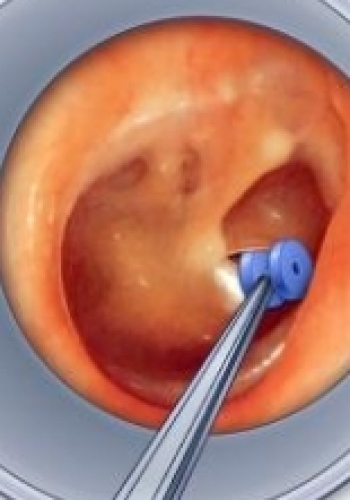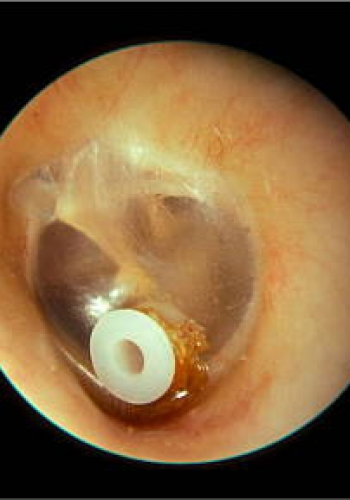Grommets
What are grommets?
Grommets (or tympanostomy tubes) are small devices used to maintain a hole in the eardrum to allow drainage of fluid from the middle ear (the space behind the eardrum) or to aid delivery of medication (antibiotic drops). They are temporary and the ear will push the grommet out over time. In rare cases, the grommet may fall out too soon or get blocked meaning another tube needs to be inserted.
Recurrent ear infections
An ear infection can be a very painful condition. If you’ve ever had one, you are familiar with the symptoms of pain and pressure in the ear. It can be associated with a fever and often has associated hearing loss. Fortunately in most cases it is brief lasting only a few days not requiring medical intervention. Most children have had at least one ear infection. For some children these infections do not settle down or are recurrent. This can result in multiple episodes of fever and illness, time off work/school and many trips to either a GP or emergency department and courses of antibiotics. For recurrent infections, if your child has had more than 4 ear infections in 6 months or 6 infections in one calendar year, grommets may de indicated.
Middle ear fluid
Middle ear fluid is often described as glue ear. Although it isn’t always thick and glue-like, persistent fluid in the middle ear (trapped behind the eardrum), is more common in children. It will cause hearing loss and affect normal speech and language development. If the fluid persists for 3 months in one ear or 6 months in one ear, and is having an impact on speech development, grommets are indicated.
Eustachian tube dysfunction
The Eustachian tube connects the middle ear (behind the ear drum) to the back of the nose. Due to the shape of the child’s skull, it is a more collapsible tube, this can lead to a negative pressure forming behind the ear drum – this is because the lining of the middle ear actually absorbs gas. We need the Eustachian tube to let air in. If this negative pressure persists, it can lead to hearing loss, and more concerningly changes to the eardrum that can lead to permanent hearing loss due to damage to the small bones of hearing (the ossicles).
Grommet removal
Grommets are designed to be extruded (naturally pushed out) by the body. In rare cases, they don’t come out. If they haven’t come out after 2 years, it may be that another operation needs to be performed in order to remove the grommet and repair the small hole in the drum. Finally, sometimes, the grommets do fall out, but the eardrum doesn’t heal, leaving a small hole in the drum. This may need to be repaired. Dr Jefferson will follow you to ensure the grommets do come out, the ear drum heals and is intact, and that the problems with the ears don’t return.
Ear Concerns in Children
Post Operative Instructions
Most people recover very quickly after having grommets placed.
Eating and drinking
There are no restrictions on eating or drinking after surgery, however, eating too much initially may result in some nausea and vomiting as the anaesthetic medication is still in your system.
Activity
You may return to normal activities the day after surgery. Travel on airplanes is generally ok after the first 72 hours. Please let Dr. Jefferson know if you plan to travel.
Getting the ears wet
Keep the ears dry for the first 2 weeks after surgery. After that, there are no water precautions necessary after grommet placement. This is based on the best available evidence. While there is a slight chance of developing an ear infection, this can typically be managed with antibiotic drops. If there are repeated infections, please contact the office.
Bleeding
You may notice a small amount of blood-tinged drainage or even clots for the first few days but do not be alarmed; this is normal. If these symptoms lasts longer than 4 days, please call our rooms 4955 8044.
Pain
Nearly all people undergoing a grommet insertion will have some mild pain/irritability on waking. This should settle down quickly.
Pain control
Panadol and Nurofen are recommended for pain relief.
Antibiotics
You will be given drops for some Ciloxin drops. Please apply 3 drops, 3 times per day for 3 days.
Post-op follow up
You will typically have a follow up appointment 6-8 weeks after surgery, along with a hearing test with our audiologist. You will then be seen every 12 months until the grommets are out, the hearing has returned to normal and the eardrum has healed. You will get a post op appointment card with the time and date of your appointment. Please contact the rooms if you have any concerns.
Infectionsmy
You can still get infections with grommets in. This will be apparent with foul-smelling discharge from the ear. If this occurs, contact your GP and start some topical antibiotic drops (Ciloxin) to the affected ear. Use the drops for 3-5 days. If the discharge persists beyond 5 days, please contact my rooms on (02) 4955 8044.






